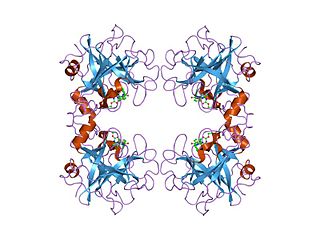
Tryptase is the most abundant secretory granule-derived serine proteinase contained in mast cells and has been used as a marker for mast cell activation. Club cells contain tryptase, which is believed to be responsible for cleaving the hemagglutinin surface protein of influenza A virus, thereby activating it and causing the symptoms of flu.

Granzyme A is an enzyme. that in humans is encoded by the GZMA gene, and is one of the five granzymes encoded in the human genome. This enzyme is present in cytotoxic T lymphocyte granules.

Leukocyte surface antigen CD53 is a protein that in humans is encoded by the CD53 gene.

Chymase is an enzyme that in humans is encoded by the CMA1 gene.

Fc fragment of IgE, high affinity I, receptor for; alpha polypeptide, also known as FCER1A, is a protein which in humans is encoded by the FCER1A gene.

Tryptase alpha-1 and tryptase beta-1 are enzymes that in humans are encoded by the same TPSAB1 gene. Beta tryptases appear to be the main isoenzymes expressed in mast cells; whereas in basophils, alpha tryptases predominate.

Chemokine-binding protein 2 is a protein that in humans is encoded by the CCBP2 gene.

Interleukin-12 receptor, beta 1, or IL-12Rβ1 in short, is a subunit of the interleukin 12 receptor. IL12RB1, is the name of its human gene. IL-12Rβ1 is also known as CD212.

Interleukin 9 receptor (IL9R) also known as CD129 is a type I cytokine receptor. IL9R also denotes its human gene.

Actin, gamma-enteric smooth muscle is a protein that in humans is encoded by the ACTG2 gene.

Interleukin 21 receptor is a type I cytokine receptor. IL21R is its human gene.

Interleukin 20 receptor, alpha subunit is a subunit for the interleukin-20 receptor. IL20RA is its human gene.

Granzyme M is a protein that in humans is encoded by the GZMM gene.

CD79b molecule, immunoglobulin-associated beta, also known as CD79B, is a human gene.

The interleukin-18 receptor 1 (IL-18R1) is an interleukin receptor of the immunoglobulin superfamily. IL18R1 is its human gene. IL18R1 is also known as CDw218a.

High affinity immunoglobulin epsilon receptor subunit beta is a protein that in humans is encoded by the MS4A2 gene.

Tryptase delta is an enzyme that in humans is encoded by the TPSD1 gene.

Tryptase beta-2, also known as tryptase II, is an enzyme that in humans is encoded by the TPSB2 gene.

Brain-specific serine protease 4 (BSSP-4), also known as serine protease 22 or tryptase epsilon, is an enzyme that in humans is encoded by the PRSS22 gene.




















